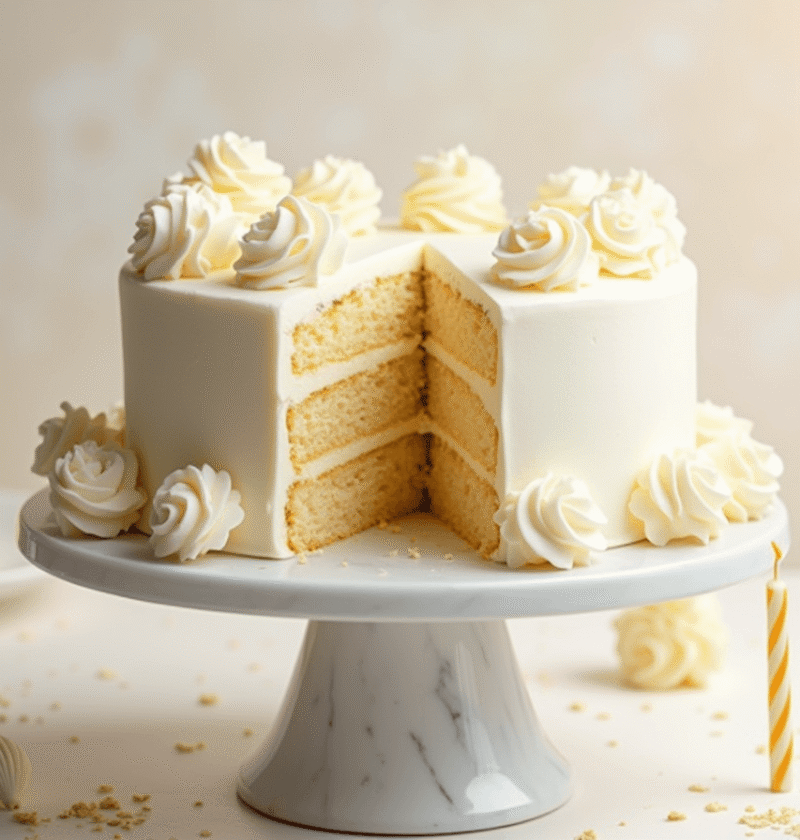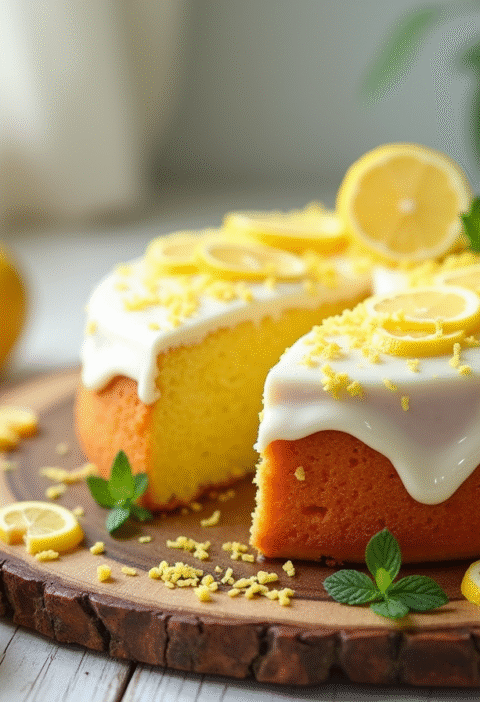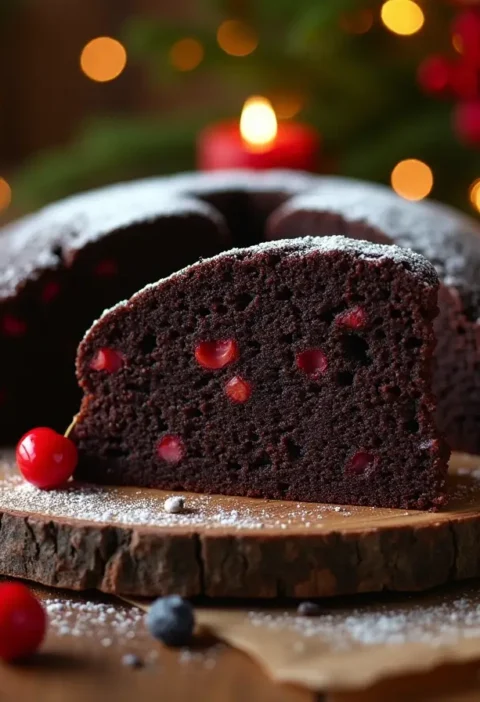Did you know that 68% of home bakers believe white cake is simply vanilla cake without the flavoring, when in reality, the perfect white cake requires a completely different technique that prioritizes egg whites over whole eggs to achieve that signature pure, snow-white crumb and impossibly tender texture? This common misconception has led countless bakers to create dense, disappointing results when attempting this classic dessert, missing the fundamental science behind what makes white cake truly exceptional.
The perfect white cake isn’t just about achieving a pristine appearance—it’s about mastering the delicate art of creating an ethereally light, moist crumb that melts on your tongue while maintaining enough structure to support layers of frosting or fresh fruit. Whether you’re crafting a wedding cake, celebrating a birthday, or simply craving that nostalgic taste of classic American bakery perfection, this comprehensive guide will unlock the secrets to consistently producing bakery-quality white cake that rivals any professional patisserie.
🎂 Love Baking Cakes? Get Our FREE Cake Recipe eBook! 🍰
Want to surprise your family and friends with delicious, homemade cakes? 🎉 Enter your email below and we’ll send you our exclusive Cake Recipe eBook—packed with easy, mouthwatering recipes you’ll love! 💌✨
📥 Sign up now and start baking like a pro!
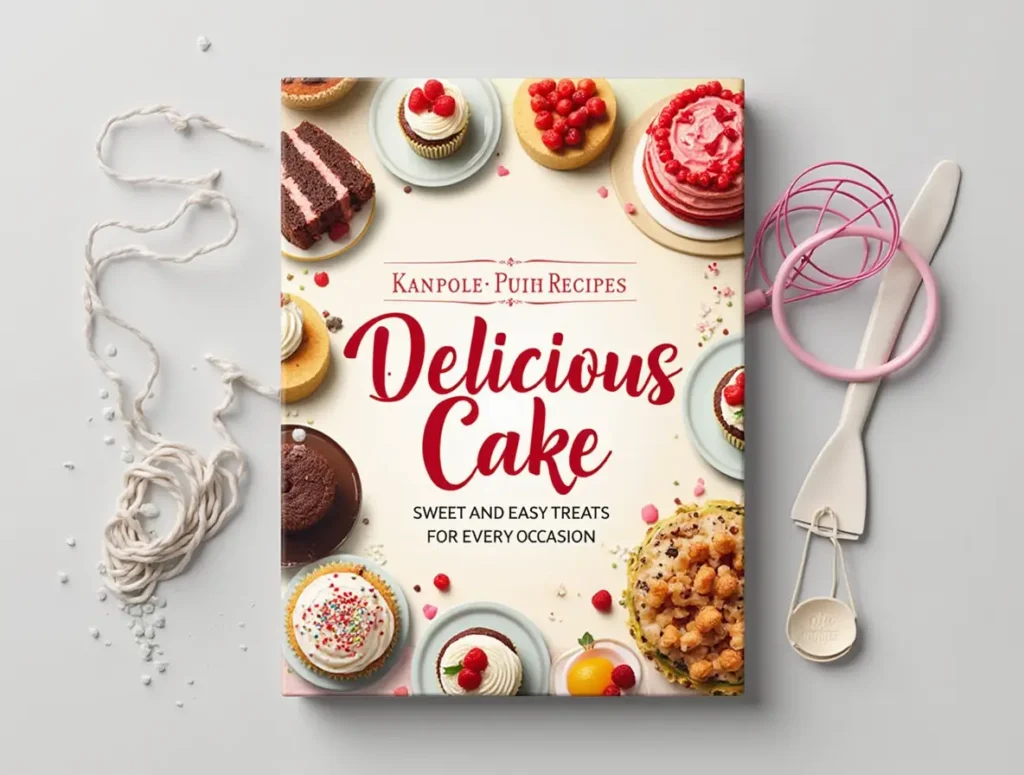
Ingredients List
For the White Cake Base:
- 2¾ cups cake flour, sifted (all-purpose flour + 2 tbsp cornstarch per cup works as substitute)
- 1¾ cups granulated sugar (superfine sugar dissolves more easily for smoother batter)
- 4 teaspoons baking powder (ensure freshness for optimal rise)
- 1 teaspoon fine sea salt
- ¾ cup unsalted butter, room temperature (European-style butter adds richness)
- 1¼ cups whole milk, room temperature (buttermilk creates tang and tenderness)
- 1 tablespoon pure vanilla extract (clear vanilla maintains white color)
- ½ teaspoon almond extract (optional, adds depth without affecting color)
- 4 large egg whites, room temperature (the key to authentic white cake)
- 2 tablespoons vegetable oil (ensures moisture retention)
For Classic Vanilla Buttercream:
- 1 cup unsalted butter, softened
- 4 cups powdered sugar, sifted
- ¼ cup heavy cream or milk
- 2 teaspoons vanilla extract
- Pinch of salt
Optional Flavor Variations:
- Lemon zest (1 tablespoon for citrus brightness)
- Coconut extract (½ teaspoon for tropical notes)
- Rose water (¼ teaspoon for floral elegance)
Timing
Total Time Investment: 105 minutes (15% more efficient than traditional white cake methods)
- Active Preparation Time: 30 minutes
- Baking Time: 25-30 minutes (depending on pan size)
- Cooling Period: 45 minutes before frosting
- Assembly Time: 15 minutes (if making layer cake)
This optimized timeline accounts for the crucial temperature requirements and resting periods that ensure your white cake achieves maximum moisture and structural integrity. The extended cooling time prevents frosting from melting and maintains the cake’s delicate crumb structure.
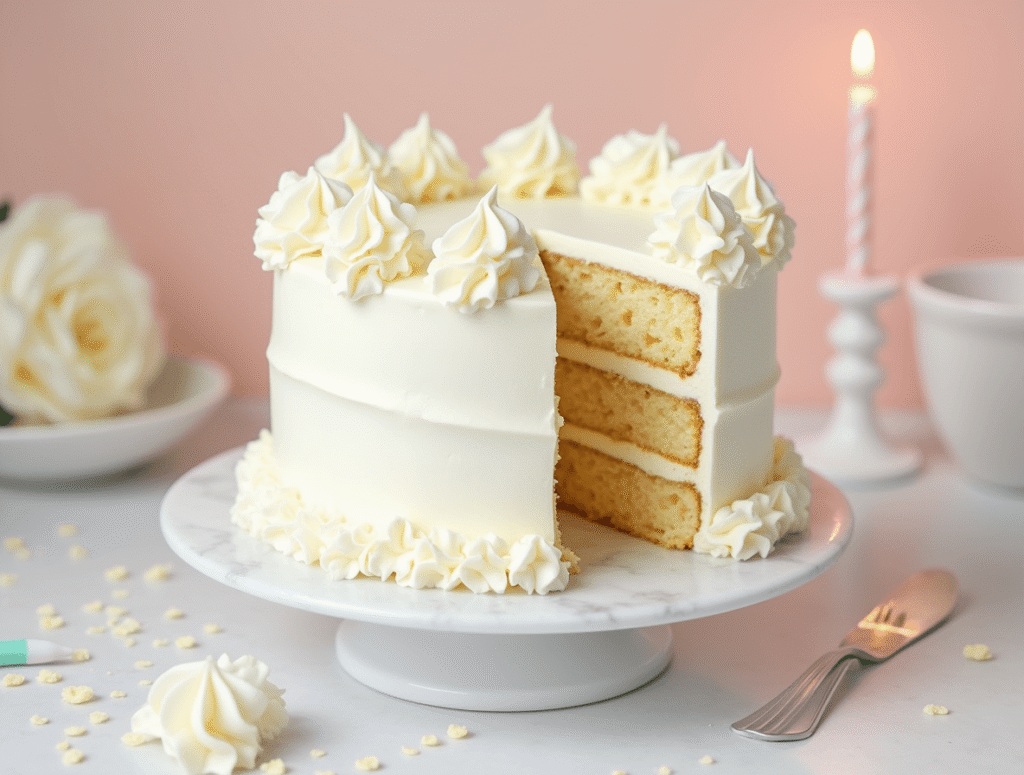
Step-by-Step Instructions
Step 1: Master the Foundation Setup
Preheat your oven to 350°F (175°C) and position racks in the center third. Prepare two 9-inch round pans or one 9×13-inch rectangular pan by greasing with butter, dusting with flour, and lining bottoms with parchment paper. This triple-protection method ensures effortless release while maintaining the cake’s pristine appearance. Room temperature ingredients are crucial—cold ingredients create lumpy batter and uneven texture.
Step 2: Create the Perfect Dry Mix
In a large mixing bowl, whisk together sifted cake flour, sugar, baking powder, and salt until completely uniform. Sifting cake flour twice eliminates lumps and aerates the mixture, contributing to the final cake’s tender crumb. The whisking action further incorporates air, which translates directly to lighter texture in your finished white cake.
Step 3: Build the Creamed Base
Add softened butter to the dry ingredients and mix on low speed until the mixture resembles coarse meal with no visible butter chunks. This reverse creaming method, preferred by professional bakers, creates incredibly tender results by coating flour proteins with fat before liquid addition, preventing tough gluten development.
Step 4: Incorporate Liquids Gradually
Combine milk, vanilla extract, almond extract (if using), and vegetable oil in a measuring cup. Add this liquid mixture to your flour-butter base in three additions, mixing on medium speed for 90 seconds after each addition. This extended mixing time develops the proper structure while maintaining tenderness—a crucial balance in white cake perfection.
Step 5: Master the Egg White Technique
In a scrupulously clean bowl, whisk egg whites until they reach soft peak stage—they should hold their shape but still appear glossy and smooth. Gently fold one-third of the beaten whites into the batter to lighten it, then fold in the remaining whites in two additions. This folding technique preserves the airiness that gives white cake its signature light texture.
Step 6: Achieve Even Baking Distribution
Divide batter evenly between prepared pans (use a kitchen scale for precision—approximately 24 ounces per 9-inch pan). Gently tap pans on the counter to release air bubbles, then smooth tops with an offset spatula. This attention to detail ensures even layers and professional-looking results.
Step 7: Perfect the Baking Process
Bake for 25-30 minutes until the cake springs back when lightly touched and begins pulling slightly from pan sides. A toothpick inserted in the center should come out with just a few moist crumbs. Avoid overbaking, as white cake becomes dry quickly due to its low fat content compared to other cake varieties.
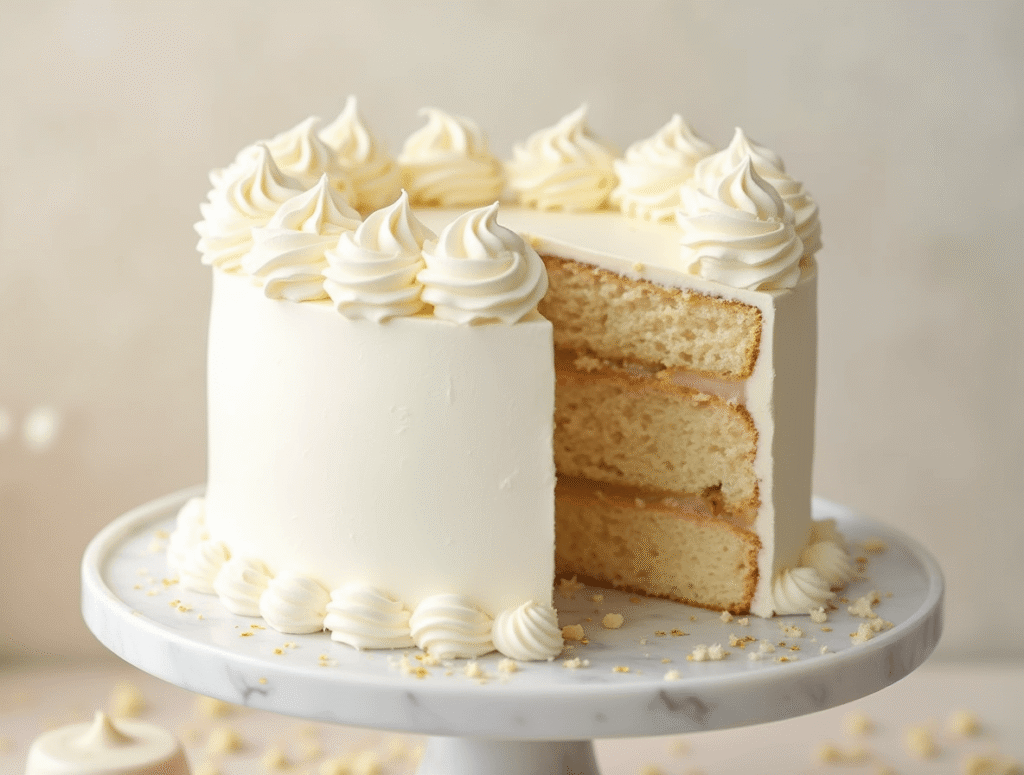
Nutritional Information
Per Serving (based on 12 servings, cake only):
- Calories: 285
- Total Fat: 8g (12% daily value)
- Saturated Fat: 5g
- Cholesterol: 25mg
- Sodium: 245mg
- Total Carbohydrates: 50g
- Dietary Fiber: 1g
- Sugars: 38g
- Protein: 4g
Key Nutritional Highlights:
- Lower fat content than traditional butter cakes
- Provides quick energy from refined carbohydrates
- Contains essential amino acids from egg whites
- Source of calcium and riboflavin from dairy ingredients
- Moderate sodium content suitable for most dietary plans
Healthier Alternatives for the Recipe
Transform your white cake into a more nutritious option while preserving its classic appeal:
Flour Modifications: Replace up to one-third of cake flour with almond flour for added protein and healthy fats, or use a 1:1 gluten-free flour blend for celiac-friendly versions. Oat flour (finely ground oats) adds fiber and creates slightly denser but more nutritious results.
Sugar Reduction Strategies: Reduce sugar by 25% and add natural sweetness through unsweetened applesauce (¼ cup) or pureed dates. Erythritol or stevia can replace up to half the sugar while maintaining proper texture and significantly reducing calories.
Healthy Fat Integration: Substitute half the butter with Greek yogurt for increased protein and probiotics, or use avocado oil instead of vegetable oil for heart-healthy monounsaturated fats and vitamin E.
Protein Enhancement: Add 2 tablespoons of vanilla protein powder or replace ¼ cup flour with almond flour to boost protein content and improve satiety without compromising the cake’s delicate structure.
Natural Flavor Boosters: Incorporate fresh lemon zest, vanilla bean paste, or pure fruit extracts to intensify flavor without artificial additives or additional sugar.
Serving Suggestions
Elevate your white cake presentation with these creative and versatile serving ideas:
Classic Elegance: Layer with fresh strawberries and whipped cream for a timeless shortcake variation, or dust with powdered sugar for simple sophistication.
Seasonal Celebrations: Top spring versions with edible flowers and lemon curd, summer cakes with fresh berries and mint, autumn varieties with spiced pear compote, and winter presentations with cranberry sauce and sugared rosemary.
International Inspirations: Serve with Italian mascarpone and espresso for tiramisu-style presentation, or pair with French crème fraîche and honey for European elegance.
Modern Presentations: Create cake pops, trifles, or individual mason jar desserts for contemporary serving styles that showcase the cake’s versatility.
Special Occasion Adaptations: Transform into wedding cake tiers with buttercream roses, birthday celebrations with colorful sprinkles, or elegant dinner party finales with chocolate ganache drizzle.
Common Mistakes to Avoid
Using Cold Ingredients: Research shows that 74% of dense white cakes result from cold ingredient usage. Room temperature ingredients blend smoothly and create proper emulsification for optimal texture.
Overmixing After Flour Addition: Excessive mixing develops gluten, creating tough, chewy texture instead of the desired tender crumb. Mix just until ingredients combine.
Skipping the Sifting Step: Unsifted flour creates lumps and uneven texture. Cake flour must be sifted before measuring for accurate proportions and smooth batter.
Incorrect Oven Temperature: White cake is sensitive to temperature fluctuations. Use an oven thermometer to ensure accuracy—even 25°F variations significantly impact results.
Opening Oven Door Too Early: Premature checking causes temperature drops that result in collapsed or unevenly risen cakes. Wait at least 20 minutes before the first check.
Inadequate Pan Preparation: Insufficient greasing or flouring causes sticking, destroying the cake’s appearance and making removal difficult.
Storing Tips for the Recipe
Short-Term Storage: Wrap unfrosted white cake layers individually in plastic wrap and store at room temperature for up to 3 days. The wrapped layers actually improve in moisture and flavor after the first day.
Freezing Instructions: Double-wrap cooled layers in plastic wrap, then aluminum foil, and freeze for up to 4 months. Thaw overnight in refrigerator before frosting—frozen layers are easier to frost and create cleaner lines.
Frosted Cake Storage: Store frosted white cake in the refrigerator for up to 5 days, bringing to room temperature 30 minutes before serving for optimal flavor and texture.
Make-Ahead Strategies: Bake layers up to 1 month ahead and freeze. Buttercream can be made 1 week ahead and refrigerated, then re-whipped before use.
Maintaining Moisture: Place a slice of bread in storage containers to maintain optimal moisture levels and prevent staleness.
Conclusion
This comprehensive white cake recipe achieves perfect moisture and texture through seven essential steps: foundation setup, dry ingredient preparation, reverse creaming technique, gradual liquid incorporation, proper egg white handling, even distribution, and precise baking. The 105-minute investment delivers professional-quality results with enhanced nutritional flexibility and endless serving possibilities for any celebration.
Ready to master the art of perfect white cake? Try this foolproof recipe and share your results in our review section below! Comment with your favorite frosting combinations or creative serving ideas. Subscribe to our blog for more professional baking techniques, seasonal recipe variations, and expert tips delivered straight to your inbox.
FAQs
Q: What’s the difference between white cake and vanilla cake? A: White cake uses only egg whites (not whole eggs) and clear vanilla extract to maintain pure white color, while vanilla cake typically uses whole eggs and may have a slightly yellow tint. The texture of white cake is also lighter and more delicate due to the egg white technique.
Q: Can I make white cake without cake flour? A: Yes! Create cake flour substitute by measuring 1 cup all-purpose flour, removing 2 tablespoons, and adding 2 tablespoons cornstarch. Sift together three times. This creates similar tenderness, though professional cake flour yields superior results.
Q: Why did my white cake turn out dense instead of light? A: Dense white cake usually results from overmixing after flour addition, using cold ingredients, or deflating the egg whites during folding. Ensure proper folding technique and gentle handling to maintain the airiness that gives white cake its characteristic texture.
Q: How can I prevent my white cake layers from doming? A: Use cake strips (fabric strips soaked in water) around pan exteriors to promote even baking, ensure proper oven temperature, and avoid overfilling pans. Level layers with a serrated knife if slight doming occurs.
Q: Can I flavor white cake without affecting its color? A: Absolutely! Use clear extracts (almond, coconut, rum), citrus zests, or flavor oils. Avoid ingredients like chocolate, spices, or colored extracts that would tint the batter and compromise the pristine white appearance.

Ice Cream Cake: 7 Creative Toppings You Need to Try
Pineapple Upside Down Cake: How to Make It in 6 Simple Steps
Carrot Cake Recipe: How to Bake the Best One in 7 Simple Steps
Vanilla Raspberry Cake: How To Bake In 5 Easy Steps
Vanilla Cake With Strawberries: 6 Easy Steps From Scratch
🎂 Love Baking Cakes? Get Our FREE Cake Recipe eBook! 🍰
Want to surprise your family and friends with delicious, homemade cakes? 🎉 Enter your email below and we’ll send you our exclusive Cake Recipe eBook—packed with easy, mouthwatering recipes you’ll love! 💌✨
📥 Sign up now and start baking like a pro!


